Androgen Conjugates: Physiology and Clinical Significance
February 1993
in “Endocrine reviews”
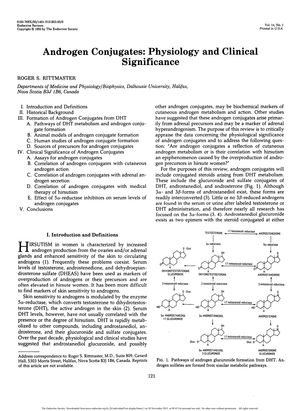
TLDR Androgen conjugates might be better indicators of skin sensitivity to hormones in women with excessive hair growth.
The document from 1993 discusses the challenge of identifying markers for skin sensitivity to androgens in women with hirsutism, a condition characterized by excessive hair growth due to increased androgen production or enhanced skin sensitivity to these hormones. While serum levels of testosterone, androstenedione, and DHEAS are often elevated in hirsute women, they do not reliably indicate skin sensitivity. The enzyme 5α-reductase, which converts testosterone to the more potent DHT, plays a role in modulating skin sensitivity, but serum DHT levels do not correlate well with hirsutism severity. The review suggests that androstanediol glucuronide and possibly other androgen conjugates, which are metabolized from DHT, may serve as better biochemical markers for cutaneous androgen metabolism and action. Some studies indicate that these conjugates primarily originate from adrenal precursors and could be markers of adrenal hyperandrogenism. The review aims to critically evaluate the physiological significance of androgen conjugates and determine whether they reflect cutaneous androgen metabolism or are simply associated with hirsutism due to the overproduction of androgen precursors.
View this study on academic.oup.com →
Cited in this study

research Effects of Finasteride (MK-906), a 5α-Reductase Inhibitor, on Circulating Androgens in Male Volunteers*
Finasteride safely lowers DHT levels without affecting testosterone.
research Clinical Usefulness of Plasma Androstanediol Glucuronide Measurements in Women with Idiopathic Hirsutism*
Measuring androstanediol glucuronide in blood is useful for assessing and tracking treatment in women with excessive hair growth.
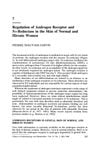
research 7 Regulation of androgen receptor and 5α-reductase in the skin of normal and hirsute women
The exact cause of increased 5α-reductase activity leading to hirsutism in women is still unknown.
research The effects of two doses of spironolactone on serum androgens and anagen hair in hirsute women
Spironolactone reduced hair thickness and some testosterone levels in women with excessive hair growth.
research 3 alpha, 17 beta-androstanediol glucuronide in plasma. A marker of androgen action in idiopathic hirsutism.
High levels of 3 alpha-diol glucuronide in the blood are a marker of increased androgen action in women with excessive hair growth of unknown cause.
Related
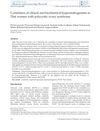
research Correlation of clinical and biochemical hyperandrogenism in Thai women with polycystic ovary syndrome
Blood tests are needed to confirm high male hormone levels in women with PCOS, as physical signs alone are not reliable.
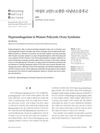
research Hyperandrogenism in Women: Polycystic Ovary Syndrome
The document concludes that more research is needed to create suitable diagnostic criteria and understand PCOS in Korean women, and genetics may allow for personalized treatment.
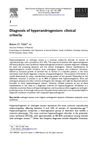
research Diagnosis of hyperandrogenism: clinical criteria
The document concludes that hirsutism is the main sign for diagnosing hyperandrogenism, which requires a detailed patient history and physical exam.
research Spironolactone therapeutic effect in the hyperandrogenism syndrome
research Metabolism of androgens by isolated human beard hair follicles
Human beard hair follicles change testosterone into other related hormones, but don't much change androstenedione into testosterone.